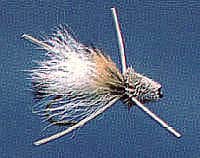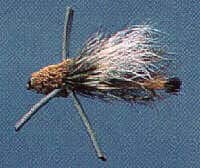The Turck Tarantula combines effectiveness, durability, and versatility for an unbeatable combination. Originally developed in 1990 as a trout pattern for Jackson Hole cutthroats, it has been used extensively throughout the western United States and numerous locales worldwide.
In the years since its creation (and especially with the advent of email) positive reports continue to pile up… from Argentina to New Zealand. The key to the Tarantula’s popularity, I believe, lies in it’s versatility. At a given time, it will work well in fast water, slow water, salt water, on the surface, submerged, dead drifted, twitched, skated, stripped in like a streamer, and even as a lake pattern. It has been used to catch trout, large and smallmouth bass, channel catfish, grass carp, perch, sea trout and others. Combine the variety of possible techniques which the fly fisher can apply with the many possible color and size variations which can be applied by the fly tyer, and you have a truly versatile pattern that can be used to imitate a wide variety of trout foods.
The original Turck Tarantula has a brown body of a natural hare’s mask and Amherst pheasant tippets for a tail. While the original Tarantula was tied with white rubber legs, I now prefer brown rubber legs on this pattern.

Original Turck Turantula
A popular variation of the original is the Golden Tarantula (shown on the right). It has a brown head and a dirty yellow body making it a good choice for hoppers and golden stones. As mentioned above, there are many possible variations and I encourage you to experiment and find what works best in your area.

Golden Turck Tarantula
It's Alive!
How can one fly pattern be effective in so many different situations?
The answer is quite simple. Despite the propaganda you may have been exposed to in many fly fishing magazines and books, much of what a trout feeds on is not simply floating motionless down the current (mayfly duns and spinners being notable exceptions). Most trout food is alive when consumed, and living entities move.
The ability to move is, in fact, a key ingredient in the scientific definition of life. So why not fish your imitation as though, it too, is alive? Bugs on or in the water may run, twitch, writhe, wiggle, skitter, dive, bounce, swim and who knows what else. Take advantage of this fact…put some action on that fly!
The design of the Tarantula makes it a natural for imitating the variety of actions just described and, again, this versatility is a major contributor to the Tarantulas effectiveness.
Like I tell my fishing clients, “It ain’t the meat, it’s the motion.“
Obviously, no technique or tactic will always work. It’s a percentage game; you should go with whatever you think is your best shot. Your best shot, however, may not be the standard or the traditional techniques. So open your mind, be creative, and have some fun while you’re at it. Follow the links in the menu at the top of the page for more info.
Guy Turck
Jackson Hole
